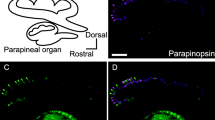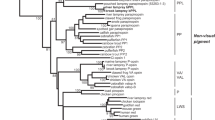Summary
A comparative study of the larval and adult pineal organs, which are sensitive to incident light, was carried out in the river lampreyLampetra japonica, using intracellular recording from the pineal photoreceptors.
-
1.
The tissue overlying the larval pineal organ is transparent, whereas that over the adult pineal is translucent. The optical density of this oval pineal window in the adult lamprey was 1.2.
-
2.
In order to elucidate the early development of the larval pineal, the ratior of the diameter (μm) of the pineal to the body-length (cm) was measured. The value ofr was 62.5 in a small larva of 2.8 cm, 29.7 in a larger one of 14.3 cm, and 9.3 in an adult of 54 cm body-length.
-
3.
The intracellular response to light of the larval pineal was a hyperpolarization, showing fundamentally the same pattern as that of the adult pineal. It was possible to record a typical response even from the pineal of the smallest larva, 2.8 cm in body length, used in this study.
-
4.
The intensity-amplitude relationship was analysed after Naka-Rushton's hyperbolic equation. The value ofσ of isolated larval pineals was 0.88 log unit higher than that of adults. The value ofn was larger in larvae, suggesting a sensitive reaction to changing photic stimulus.
-
5.
The spectral sensitivity was compared. The peak was at 505 nm in the larva, but 525 nm in the adult. A change of visual pigment in the pineal during metamorphosis is suggested.
Similar content being viewed by others
References
Bagnara JT (1960) Pineal regulation of the body lightening reaction in amphibian larvae. Science 132:1481–1483
Charlton HM (1966) The pineal gland and color change inXenopus laevis Daudin. Gen Comp Endocrinol 7:384–397
Cole WC, Youson JH (1981) The effect of pinealectomy, continuous light, and continuous darkness on metamorphosis of anadromous sea lampreys,Petromyzon marinus L. J Exp Zool 218:397–404
Cole WC, Youson JH (1982) Morphology of the pineal complex of the anadromous sea lamprey,Petromyzon marinus L. Am J Anat 165:131–163
Collin JP (1969) Contribution à l'étude de l'organe pinéal. De lépiphyse sensorielle à la glande pinéale: Modalités de transformation et implications fonctionnelles. Ann Stat Biol Besse-en-Chandesse [Suppl] 1:1–359
Collin JP (1971) Differentiation and regression of the cells of the sensory line in the epiphysis cerebri. In: Wolstenholme GEW, Knight J (eds) The pineal gland. J & A Churchill, London, pp 79–125
Dartnall HJA (1953) The interpretation of spectral sensitivity curves. Br Med Bull 9:24–30
Eddy JMP (1969) Metamorphosis and the pineal complex in the brook lamprey,Lampetra planeri. J Endocrinol 44:451–452
Ekström P, Borg B, Veen Th van (1983) Ontogenetic development of the pineal organ, parapineal organ and retina of the three-spined stickleback,Gasterosteus aculeatus L (Teleostei). Cell Tissue Res 233:593–609
Joss JMP (1973) The pineal complex, melatonin, and color change in the lampreyLampetra. Gen Comp Endocrinol 21:188–195
Meiniel A (1980) Ultrastructure of serotonin-containing cells in the pineal organ ofLampetra planeri (Petromyzontidae). Cell Tissue Res 207:407–427
Morita Y (1975) Direct photosensory activity of the pineal. In: Knigge KM et al. (eds) Brain-endocrine interaction II. The ventricular system. Karger, Basel, pp 376–387
Morita Y, Dodt E (1971) Photosensory responses from the pineal eye of the lamprey (Petromyzon fluviatilis). Proc Int Un Physiol Sci 9:405
Morita Y, Dodt E (1973) Slow photic responses of the isolated pineal organ of lamprey. Nova Acta Leopoldina 38:331–339
Morita Y, Tabata M, Tamotsu S (1985) Intracellular response and input resistance change of pineal photoreceptors and ganglion cells. Neurosci Res [Suppl] 2:S79-S88
Naka KI, Rushton WAH (1966) S-potentials from luminosity units in the retina of fish (Cyprinidae). J Physiol 185:587–599
Pu GA, Dowling JE (1981) Anatomical and physiological characteristics of pineal photoreceptor cell in the larval lamprey,Petromyzon marinus. J Neurophysiol 46:1018–1038
Veen Th van, Ekström P, Nyberg L, Borg B, Vigh-Teichmann I, Vigh B (1984) Serotonin and opsin immunoreactivities in the developing pineal organ of the three-spined stickleback,Gasterosteus aculeatus L. Cell Tissue Res 237:559–564
Author information
Authors and Affiliations
Rights and permissions
About this article
Cite this article
Tamotsu, S., Morita, Y. Photoreception in pineal organs of larval and adult lampreys,Lampetra japonica . J. Comp. Physiol. 159, 1–5 (1986). https://doi.org/10.1007/BF00612489
Accepted:
Issue Date:
DOI: https://doi.org/10.1007/BF00612489




